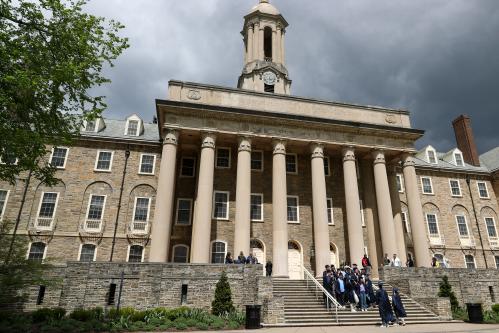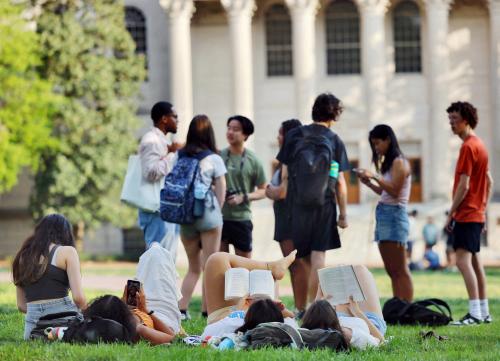Too many policies and practices aiming to improve college access and admissions overlook an important group of prospective enrollees: current college students. Substantial policy attention is placed on supporting college applications and decisions for those applying straight from high school. But one million students switch into a new college each year. The most common starting point is a community college, where more students start their postsecondary education than any other type of college.
Transferring from a community college to a four-year program is common and can be appealing for several reasons. First, students starting at community colleges may pay less tuition and have more flexible academic schedules than those starting at a four-year institution. Second, students who are undecided about what degrees and colleges suit them can gain college experience while continuing to explore their various options. Finally, transferring can offer a second chance to students who have the academic potential but not the high school academic record to gain admissions through traditional freshman admissions. So, it may not come as a surprise that about half of all students with a bachelor’s degree attended multiple colleges before graduating.
Surveys suggest that there would be even more college transfers and bachelor’s degrees if the transfer process were improved. Although 80% of community college students aspire to earn a bachelor’s degree, only 14% do so – with substantial variation across states. That’s because most never transfer. Of those who do transfer, most choose non-selective colleges that have relatively few resources and low graduation rates. These patterns persist even though transfer students graduate at similar rates to non-transfer students, even at highly selective colleges. This suggests factors besides academics drive whether transfer-intending students ultimately earn a bachelor’s degree.
The lack of informational resources and advising during the complicated and opaque transfer admissions process deters many talented students from considering more selective colleges, (i.e., those that reject most applicants). The application and admissions process can be even more complicated for community college students since they may have less access to transfer-specific and personalized advising through formal channels (like advisors and free college search tools) and informal channels (like college-educated peers and family members).
Clearing up transfer admissions standards improved access and completion
So, what can improve transfer and subsequent college outcomes? One evidence-based approach is to make admissions standards clear and transparent. In a new study, I examined what happened after three highly selective four-year public colleges in Virginia established guaranteed admissions agreements (GAAs) starting in 2006-07. These three public four-year institutions are within the nation’s top 10% of colleges in terms of graduation rates and earnings—but only six percent of all community college graduates in Virginia ever transferred to any of these four-year colleges before GAAs were implemented. Instead, the vast majority transferred to regional colleges, even among those who performed well during their community college experience.
In an effort to increase transfers and outcomes, the state higher education board directed its colleges to announce policies that would admit community college students who met certain grade, course, and credit requirements. Notably, the three most selective public colleges in Virginia publicized a GPA-based transfer standard (3.4 or 3.6) that corresponded with a guaranteed acceptance. Since the typical admitted transfer student already met these GPA standards, this approach provided prospective transfer students with greater clarity about transfer eligibility and admissions prospects. The introduction of the GAAs, and in particular the GPA thresholds, were publicized on colleges’ websites, in newspapers, and in their outreach materials. These guaranteed admissions agreements applied to graduates from all 23 community colleges in the state.
More transparent and certain admissions increased high-achieving community college students’ transfer rates to highly selective four-year colleges by 30%, increased their on-time completion of a bachelor’s degree by 32%, and reduced their average total student loan debt by $1,740, about 24%. The decrease in loan debt was even larger for the lowest income students (proxied by Pell grant receipt) who borrowed about $4,900 less.
Students with high GPAs primarily shifted their transfer decisions from regional and private colleges to highly selective public four-years, which helps explain the increased graduation rates and decreased borrowing. Consistent with other studies, the lowest income students (proxied by Pell grant receipt) borrowed significantly less after enrolling at highly selective public institutions, where students accessed more institutional aid relative to regional and private colleges.
From the institutional level, overall college access improved and more students graduated. The share of transfer students—particularly Pell grant recipients and non-white students—increased at each of the three highly selective public four-years. The net share and number of community college graduates earning a bachelor’s degree from all public four-years also increased. Furthermore, these results can generalize more broadly, since Virginia’s enrollment patterns, transfer rates, and college options resemble national trends.
While many hoped the GAAs would improve preparation and efficiency in course-taking in college, there is little evidence that they did. Although the GAAs listed specific pre-requisites recommended to satisfy particular colleges’ general education requirements, most students who applied for transfer did not complete the full set of pre-requisites. This may be because courses were less salient and accessible to prospective students, requiring them to digest the fine print in the agreements—whereas the GPA-based standards were highlighted in each announcement. Still, the vast majority of students induced to transfer to the highly selective four-year institutions graduated with their bachelor’s within three years, suggesting that not completing pre-requisites during their associate degree was not a major barrier to graduation.
Transfer students already met or exceeded the GPA standards used in the GAAs, thus the policy effect is driven by making those standards clear and transparent to potential students for the first time. This first-of-its-kind statewide policy differed from the status quo used in other states and colleges, which was to guarantee that credits from a community college degree would count towards a bachelor’s degree—often through articulation agreements. Yet evidence on articulation agreements show they have mixed effects, at best, on transfer and completion.1 Further, admissions deans and counselors said they did not invest any new financial resources in the design or implementation of the GAAs. This no-cost admissions policy was more effective at increasing students’ enrollment at selective institutions than personalized college information and tools like Navience that are available to high school students, and comparable to another state’s Percent Plans. And unlike holistic admissions used in many selective colleges across the U.S., where students face the daunting task of maximizing their performance on multiple dimensions such as essays and extracurriculars, the GAAs focused admission on GPA standards, which admissions counselors cite as the most important and predictive pieces of information used to decide which transfer students to admit.
GPA-based admissions practices reduced uncertainty and made transferring salient
When highly selective colleges clearly communicated a guaranteed admissions pathway for community college students, transfers and subsequent bachelor’s degree completion increased.
These results show that information about academic qualifications can affect enrollment decisions, consistent with other studies showing that more students would attend highly selective public four-years if they knew they were qualified. Recent research shows that increasing transparency in the financial aid application process can significantly increase enrollment at selective public colleges because students value certainty.
Clear and transparent admissions standards can make a difference in students’ college choices and success, particularly when personalized support and advising can be hard to find.







